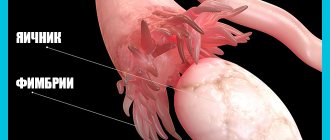Preeclampsia is a syndrome that occurs exclusively during pregnancy and is characterized by the development of hypertension and proteinuria after the 20th week. It is generally accepted that preeclampsia occurs more often in primiparous women, but in multiparous women it can also occur, especially if there are predisposing factors [pregnancy with twins, diabetes mellitus, chronic hypertension or a change of husband (sexual partner)]. If preeclampsia develops at the beginning of the 2nd trimester (14-20 weeks), it is necessary to exclude hydatidiform mole and choriocarcinoma.
There are two criteria for preeclampsia:
- - the occurrence of hypertension (systolic pressure more than 140 mm Hg, diastolic pressure more than 90 mm Hg) after the 20th week of pregnancy against the background of previously normal blood pressure;
- - the occurrence of proteinuria after the 20th week of pregnancy.
Proteinuria is defined as the presence of 0.3 g of protein or more in 24-hour urine or 30 mg/dL (“+” on the test strip) or more in a properly collected urine sample.
Previously, the criterion for preeclampsia was an increase in systolic pressure of 30 mm Hg. or diastolic - by 15 mm Hg. Since a physiological increase in pressure in the third trimester has already been proven and there is often no data on the exact pressure indicator before pregnancy, which could be taken as the initial one, the increase is currently up to 140/90 mm Hg. is not considered a diagnostic criterion for preeclampsia. Despite this, an increase in blood pressure should attract the doctor’s attention; it may precede the onset of full-blown preeclampsia syndrome. Also, preeclampsia is often preceded (accompanied by) generalized edema. Congestive edema (swelling of the lower extremities) is often noted during normal pregnancy. Swelling of the hands and face is more typical of preeclampsia, but in the absence of hypertension and proteinuria, it is not considered diagnostic of preeclampsia.
Depending on the degree of hypertension and proteinuria, as well as the severity of damage to other organ systems, two forms of preeclampsia are distinguished: mild and severe.
A variant of severe preeclampsia is HELLP syndrome. It develops in women with preeclampsia and manifests as hemolysis, decreased platelet counts, elevated liver enzymes, and decreased liver enzymes (thrombocytopenia). Unlike typical preeclampsia, HELLP syndrome most often occurs in multiparous women over 25 years of age before the 36th week of pregnancy.
Initially, in 20% of cases there may be no hypertension, in 30% there is a slight increase in blood pressure, in 50% there is a significant increase.
Preeclampsia in pregnancy
In the process of bearing a child, a woman’s body experiences serious changes and overloads. It is not always possible to maintain health, which is why every expectant mother needs constant monitoring by doctors. Even so, she may end up with a condition called pregnancy preeclampsia. What it is?
It can be expressed in different ways, a woman may not even feel any discomfort and believe that her pregnancy is proceeding completely normally. Most doctors call this gestosis, using the term “preeclampsia” only in relation to a fairly acute condition characterized by a number of other symptoms. But it all starts with fairly harmless signs.
Consequences
Without proper therapy, women experience severe complications of preeclampsia. As a result of high blood pressure, the blood supply to the placenta deteriorates, in which case oxygen does not reach the fetus in adequate quantities. There is a lack of nutrients, which leads to inhibition in the child’s development. For the mother, preeclampsia poses no less a threat. With pathology, there is a bad effect on internal organs such as the liver and kidneys. Preeclampsia negatively affects the central nervous system of pregnant women.
Development of eclampsia
As the disease develops, it can be fatal for both mother and child.
Eclampsia and preeclampsia are closely related. Eclampsia often becomes one of the most serious consequences of preeclampsia, which can be fatal for the mother and fetus. The woman experiences constant convulsions and a pre-coma state. Main signs of pathology:
- severe swelling;
- arterial hypertension;
- a large amount of protein in urine;
- damage to the central nervous system.
Sometimes the above signs do not bother a woman during pregnancy. But if a few days or weeks after childbirth there is a sharp deterioration in the woman’s well-being, then it is necessary to urgently contact an ambulance. A severe headache and other negative signs may indicate that a woman has developed postpartum eclampsia due to preeclampsia.
Causes
If doctors are absolutely clear about what preeclampsia in pregnant women is, then why it occurs is difficult to say. There are certain risk factors that can increase the likelihood of its occurrence, but they do not always work. And if a woman may encounter this phenomenon during her first pregnancy, then not in subsequent ones. Doctors tend to say that a high percentage of body fat, disruption of the proper functioning of the vascular system, and poor nutrition are to blame. But even eliminating all this, it cannot be guaranteed that such a problem will not arise.
By the way, preeclampsia can also occur immediately after childbirth, so there is a possibility that malfunctions in the hormonal or several systems at once are to blame. In any case, if you have ever experienced signs of preeclampsia during pregnancy, when planning your next one, you should consult with several specialists at once, including a hematologist, endocrinologist and, of course, an obstetrician-gynecologist.
What are the prerequisites for the development of preeclampsia in each specific pregnant woman?
We doctors call these prerequisites risk factors. The more risk factors a pregnant woman has, the higher her likelihood of developing PE becomes. These are the factors:
- late reproductive age of the mother;
- overweight;
- Afro-Caribbean and South Asian ethnicities;
- a history of chronic arterial hypertension, diabetes mellitus, systemic lupus erythematosus, anti-phospholipid syndrome;
- pregnancy resulting from the use of assisted reproductive technologies (IVF);
- presence of a family or personal history of PE.
We also note that the risk of PE in primigravidas is three times higher than in multigravidas with uncomplicated previous pregnancies. Women who have PE during their first pregnancy have a tenfold risk of developing PE in their next pregnancy. The risk of PE is lower in tall women than in short women and is reduced in parous women with no history of PE in a previous pregnancy. If the interval between previous and current pregnancies is > 15 years, the risk of developing PE becomes equivalent to that of nulliparous women. We see that PE can also occur in a primigravid woman who, before pregnancy, did not know that she had any diseases or conditions that could lead to the development of PE.
Origin and course
A woman experiences a fairly large number of unpleasant symptoms, which should alert her even before serious preeclampsia in pregnant women begins. What it is?
Firstly, it is a rise in blood pressure to fairly high values. This may not be felt at all, especially if the expectant mother neglects regular visits to the doctor and does not measure this indicator herself.
Secondly, this is serious swelling, which is almost impossible to get rid of. A sharp weight gain, heaviness in the legs and their swelling by the end of the day - this can to some extent be considered as normal phenomena for pregnancy, which you can try to stop with a more balanced diet and the introduction of cranberry juice into the diet. But if such measures do not help, and the condition only worsens, combined with high blood pressure, it makes sense to talk about gestosis - the so-called toxicosis of the second half of pregnancy.
The third sign that mild preeclampsia may soon occur in pregnant women is the presence of protein in a urine test. This means that the kidneys are seriously affected; they simply cannot cope with the load and begin to fail. If the disease is further ignored, other, more dangerous signs of preeclampsia in pregnant women appear.
SEVERE PRE-ECLAMPSIA IS AN CURRENT PROBLEM OF MODERN OBSTETRICS (Literature review)
UDC: 618.1-007:613.24
Z.E. YERZHAN, R.M. RAEVA, G.N. Moshkalova, B.B. SAGATBEKOVA, G.I. ABDULOVA, A.ZH. BAYMESHOVA, Y.S.IVANOVA,
S.K. ZHURUMBAEVA, D.N. IMIROVA, M.N. MEZENTSEVA
Kazakh National Medical University named after S.D. Asfendiyarova
Department of Internship and Residency in Obstetrics and Gynecology
Preeclampsia is one of the most complex and important problems of scientific and practical obstetrics. This article reflects maternal mortality rates according to WHO, the Republic of Kazakhstan and the Russian Federation, which show that preeclampsia remains a pressing problem in modern obstetrics throughout the world. A comparative analysis of maternal mortality from preeclampsia in the Republic of Kazakhstan for 2009-2011 was carried out. Also, the article discusses modern aspects in the tactics of management and delivery of pregnant women with preeclampsia and eclampsia.
Key words: preeclampsia, eclampsia, pregnancy, maternal mortality, hypertension.
Preeclampsia is a multisystem syndrome that reflects the inability of the maternal body's adaptive mechanisms to adequately meet the needs of the developing fetus, which is expressed by increased blood pressure and proteinuria.
Preeclampsia is one of the most complex and important problems of scientific and practical obstetrics. According to WHO, preeclampsia is diagnosed in 28% of pregnant women, making up the bulk of all hypertensive conditions during pregnancy. Preeclampsia complicates 1.3% to 6.7% of all pregnancies and remains a leading cause of maternal and perinatal morbidity and mortality worldwide [1]. According to WHO, preeclampsia is diagnosed in 28% of pregnant women, making up the bulk of all hypertensive conditions during pregnancy. In highly developed countries of the world, maternal mortality from hypertensive disorders averages 20%. According to an analysis of the causes of maternal mortality for 2005, it was found that the cause of death in half of the cases is severe preeclampsia (51.1%), every second of which dies from cerebral coma (50%), every fourth - from bleeding due to preeclampsia ( 22.7%). In the general population, hypertensive disorders occur in 11% of cases, of which in every third woman the course of the gestational process is complicated by varying degrees of severity, of which almost every fourth has a severe form [2]. Preeclampsia is usually diagnosed by the presence of hypertension and proteinuria after 20 weeks of pregnancy. Potentially fatal complications include premature placental abruption, disseminated intravascular coagulation (DIC), cerebral hemorrhage, liver failure, and acute renal failure. Despite certain advances in the treatment and prevention of preeclampsia, it still remains one of the main causes of maternal mortality, perinatal morbidity and mortality [1].
Preeclampsia is a condition that occurs in pregnant women. It is characterized by high blood pressure and the presence of protein in the urine. In addition, patients with preeclampsia often experience swelling in the legs and arms. Preeclampsia usually occurs in the second half of pregnancy, at the end of the second or third trimester, although it can occur earlier. Risk factors include: preeclampsia/eclampsia in a previous pregnancy, family history of preeclampsia, multiple pregnancies, and for severe preeclampsia: severe hypertension + proteinuria, any degree of hypertension + proteinuria + one of the following symptoms - severe headache, blurred vision, pain in the epigastric region and/or nausea, vomiting, convulsive readiness, generalized edema, oliguria (less than 30 ml/hour or less than 50 ml of urine in 24 hours), pain on palpation of the liver, platelet count below 100x109 g/l, increased levels of liver enzymes , HELLP syndrome [3].
In the general population of pregnant women, the incidence of preeclampsia is 5-10%, and eclampsia - 0.05%. In the global structure of maternal mortality, the share of preeclampsia is 12-15%, and in developing countries this figure reaches 30% [4].
In developed countries, rates of maternal and perinatal mortality associated with preeclampsia are an order of magnitude lower than in developing countries, which indicates the manageability of complicated forms of preeclampsia and the possibility of effectively influencing the outcome with a systematic approach to this problem [4].
In the Republic of Kazakhstan, at the end of 2009, preeclampsia and eclampsia were the cause of maternal mortality in 11 women (the maternal mortality rate was 8.3 per 100 thousand live births), occupying third place in the structure of causes of maternal mortality after extragenital diseases and obstetric hemorrhage. In 2010, 12 cases of maternal mortality from severe preeclampsia and eclampsia were registered, the maternal mortality rate was 3.3 compared to 8.3 in 2009 per 100 thousand live births. In 2011, mortality from preeclampsia and eclampsia was noted in 6 cases, the maternal mortality rate was 1.6 per 100 thousand live births. However, the reduction in the maternal mortality rate from preeclampsia and eclampsia over these 3 years imposes a huge responsibility on all obstetricians and gynecologists of our Republic, since the more difficult it is to achieve its further reduction, the more difficult it is to maintain the priming of the indicator. Analysis of primary medical documentation in all cases of maternal mortality showed that there was: underestimation of the severity of the condition at the outpatient clinic level, untimely hospitalization, underestimation of the severity of the disease, unreasonable long-term treatment, non-compliance with the protocol and standards, delayed delivery, unpreparedness of hospitals to provide emergency care with eclampsia [4].
According to Russian authors, this pathology remains one of the main causes of maternal mortality and accounts for about 20% of all cases of maternal deaths in the Russian Federation. In Moscow, maternal mortality from various forms of preeclampsia and their complications ranks first among all causes of maternal mortality, ranging from 17 to 28% per year, i.e. The share of preeclampsia turned out to be slightly higher than in Russia as a whole. Currently, due to the improvement of treatment methods, obstetric tactics, the emergence of new methods of intensive care and resuscitation, the life expectancy of postpartum women suffering from preeclampsia (90% of women lived more than 72 hours after childbirth) and eclampsia (more than 72 hours after convulsions) has increased significantly. 54%) compared with rapid deaths in the 70s (51.0% of women died in the first 24 hours after an eclamptic seizure) [5,6,8].
In Russia, as in other countries, the incidence of preeclampsia is increasing. According to industry statistics from the Ministry of Health and Social Development of the Russian Federation, the national average incidence of preeclampsia in pregnant women was: 1998. — 18.5%; 2000 — 22.2%; 2006 - 21.6%. Preeclampsia, as a direct cause of death, ranks third in the structure of maternal mortality and amounts to 12-15%; with severe preeclampsia and its critical forms, maternal mortality rates are 20-25%. Perinatal mortality in preeclampsia ranges from 10.0 to 30.0%, perinatal morbidity in them is 463-780%.
Preeclampsia is one of the main causes leading to the development of placental insufficiency, the frequency of which ranges from 26.8% to 37.2% [6]. Preeclampsia is also dangerous in the postpartum period and is equally dangerous for the life of mother and child. With preeclampsia, the functions of vital organs are disrupted: kidneys, brain, liver, lungs, which often leads to the development of multiple organ failure. The consequences of preeclampsia manifest themselves not only in the early postpartum period, but also in subsequent years of a woman’s life, and above all this concerns the functions of the brain.
Preeclampsia requires close attention. Of the total number of deaths from preeclampsia, 96.8% of women died after childbirth [4,7]. To predict long-term postpartum complications in women who have suffered preeclampsia, indicators of central and cerebral hemodynamics are used, obtained using the method of integral body rheography and rheoencephalographic study of cerebral blood flow. A number of authors have proposed using “quality of life” for such an assessment; in particular, S.V. Govorov and G.Ya. Klimenko (2007) carried out such an assessment using the Russian version of the international program Medical Outcomes Study Short Form (SF-36). An objective integrative assessment of the violation of the functional-adaptive status of the body of postpartum women is carried out in the postpartum period due to preeclampsia. This was made possible through the use of a cardiorespiratory synchrony test. This test shows the possibility of predicting the development of postpartum complications in postpartum women who have had preeclampsia in order to prevent these complications. Currently, none of the methods for predicting preeclampsia can be recommended as a universal screening test to determine the risk of preeclampsia, because there are 40 theories of the etiology and pathogenesis of preeclampsia [7,8].
According to modern ideas about preeclampsia, the leading role in the pathogenesis of hypertensive disorders is assigned to damage to the prostaglandin system, which has a pronounced pressor and depressor effect on the vascular wall. It is known that platelet aggregation in the vascular bed is under the regulatory influence of a number of inhibitors and activators of this process. An important role in the regulation of functional activity belongs to prostacyclins, an imbalance of which can become one of the causes of disturbances in central and peripheral hemodynamics, which leads to hypovolemia, impaired microcirculation, increased blood pressure and multiple organ failure [8].
Also, with preeclampsia, placental perfusion is impaired (stage 1) and due to insufficient remodeling of the spiral arteries supplying the intervillous space, factors arise that lead to clinical manifestations of preeclampsia (stage 2). This hypothesis is based on compelling evidence of increased concentrations of biomarkers of oxidative stress and decreased concentrations of antioxidants such as vitamins C and E in the serum and tissues of women with established preeclampsia. Antioxidants play an important role in maintaining cellular function in normal pregnancy and act by inhibiting peroxidation, thereby protecting enzymes and proteins. Results from a randomized controlled trial showed that vitamin C and E supplementation were associated with a significant reduction in maternal concentrations of biomarkers for preeclampsia (plasminogen activator inhibitor [PAI]-1-to-PAI-2 ratio), with a 54% reduction in risk preeclampsia, a 37% reduction in the risk of placental abruption was also found [1,5,9].
The basic drug in the treatment of preeclampsia and eclampsia is magnesium sulfate, administered at a concentration of 25%, the initial dose is 4 grams of dry matter over 10-15 minutes IV, slowly, then a maintenance dose of 1-2 g/hour is administered. Routine use of magnesium sulfate for the treatment of preeclampsia has been shown to have a significant impact on maternal mortality rates. Magnesium therapy should be carried out continuously at any stage of pregnancy, during childbirth and the postpartum period. Despite this, magnesium sulfate is not a definitive treatment for severe preeclampsia. Delivery is the only effective treatment for severe preeclampsia [4;9].
In this aspect, the correct assessment of clinical symptoms and justified, rational intensive drug therapy in critical conditions is one of the criteria for favorable outcomes during pregnancy and childbirth. Improving the methods and principles of treatment is possible only on the basis of developing the principles of intensive therapy, monitoring the treatment process using monitoring of small hemodynamic profiles (BP, HR, CVP, CO, OPSS). With preeclampsia of varying severity, unjustified drug therapy is the cause of increased perinatal and maternal morbidity and mortality.
Maternal and perinatal morbidity and mortality are also influenced by the method of delivery for preeclampsia. Since preeclampsia is common in preterm pregnant women, the rate of cesarean section is estimated to be high. Vaginal delivery is preferable to operative delivery. According to the literature, cesarean section rates are 70% or more for preterm pregnancies because many obstetrician-gynecologists prefer to perform cesarean section in these patients, even if the fetal condition allows vaginal delivery. However, it has not yet been proven that cesarean section improves neonatal outcome and maternal mortality. Conversely, observational studies suggest that vaginal delivery may be better in the long term for preterm infants, also offering maternal benefits with fewer complications, shorter hospital stays with lower complication rates, and shorter hospital stays. In addition, the incidence of neonatal cerebral palsy remains the same [2,4].
At the present stage, vaginal delivery for severe preeclampsia is becoming an alternative to surgical delivery. Several methods are used to induce labor, depending on the degree of maturity of the cervix. When the cervix is immature, hydrophilic dilators (kelp) and prostaglandins (PG) are used to ripen it. Particular interest in prostaglandins is determined by their ability to stimulate the contractile activity of the myometrium at any stage of pregnancy. Cervical ripening with the use of prostaglandins increases the likelihood of successful induction of labor and achieving delivery within 12-24 hours. In recent years, the use of the synthetic drug misoprostol (PGE) has been intensively studied to accelerate cervical ripening and induce labor, including in women with severe preeclampsia. In addition, preparation with misoprostol reduces the need for oxytocin infusion to enhance uterine activity, and the number of deliveries by cesarean section is reduced. When using misoprostol, there is some concern that it can provoke excessive contractile activity of the uterus. However, perinatal outcomes were not significantly different [1,5].
Another important problem in preeclampsia is determining the indications for emergency delivery and the gestational age at which complications for children will be minimal. In this regard, the opinions of scientists are divided. Some scientists advocate the tactics of early delivery to avoid maternal complications (eclampsia, placental abruption, HELLP syndrome, cerebral hemorrhage, acute renal failure, and others) [8]. Other scientists advocate the tactics of prolonging pregnancy in order to avoid complications from the fetus associated with its immaturity (respiratory distress syndrome, cerebral hemorrhage, necrotizing enterocolitis, and others). As practice shows, therapy carried out by obstetricians is effective in 80 - 100% of patients. But it is precisely 10-20% of patients resistant to conventional therapy that account for the majority of severe complications. Delaying delivery until the degree of fetal maturity increases poses a risk to the life of both mother and fetus [5].
According to various authors, the incidence of preeclampsia ranges from 7% to 16%. Preeclampsia develops in 6-12% of healthy pregnant women, 20-40% in pregnant women with extragenital pathology. According to WHO, preeclampsia occupies one of the first places in the structure of maternal mortality, being the cause of premature birth, premature abruption of a normally located placenta, the development of fetoplacental insufficiency, intrauterine growth retardation, and the birth of low birth weight children. According to various authors, preeclampsia as a cause of perinatal mortality ranks 1st - 2nd. Perinatal losses in preeclampsia are 4 times higher than in the group of healthy women. Among children born alive to mothers with preeclampsia, every fourth child is delayed in physical development. Despite numerous studies devoted to the problem of preeclampsia, many issues of the etiology, pathogenesis and genetics of this pregnancy complication remain controversial. None of the hypotheses for the occurrence of preeclampsia provides an answer to all questions related to this complication of pregnancy [4,6,8].
Thus, among the many problems associated with preeclampsia and eclampsia, the problem of diagnosis, prognosis and assessment of severity occupies one of the most important places and is of great importance for both obstetricians-gynecologists and anesthesiologists-resuscitators. Reducing perinatal and maternal morbidity and mortality remains the main goal of obstetricians and gynecologists. Its solution is impossible without reliable methods for predicting the course of pregnancy and the condition of newborns, which involve the timely use of therapeutic and preventive measures to eliminate adverse outcomes of pregnancy and childbirth. In this regard, it should be recognized that it is urgent to search for new prognostic and diagnostic criteria for the unfavorable course of pregnancy and childbirth, which will allow timely identification of a group at increased risk of perinatal complications in order to prevent or reduce the severity of such complications [1].
To reduce maternal mortality from preeclampsia and eclampsia, it is necessary to: take into account and identify risk factors for the development of preeclampsia, ensure proper monitoring of pregnant women at risk for preeclampsia, comply with the diagnostic criteria for preeclampsia when making a diagnosis, adhere to the principles of regionalization for preeclampsia, strict implementation of protocols when conducting magnesium and infusion therapy, compliance with delivery standards for preeclampsia and eclampsia, clinical examination of women with extragenital diseases, their rehabilitation and treatment, integration of perinatal centers with multidisciplinary hospitals [4].
Bibliography
1 H. Critchley, A. Poston, J. Walker, Pre-eclampsia, RCOG Press, London (2003), pp. 189-207
2 Alanis MC, Johnson DD. Early initiation of severe preeclampsia induction of labor is versus elected cesarean delivery and newborn//American Journal of Obstetrics and Gynecology 2008; 199 (3): 262.e1-262.e6.
3 Protocols of the Ministry of Health of the Republic of Kazakhstan No. 262 dated May 4, 2011.
4 Biktasheva Kh.M. and others. Preeclampsia in the “mother-placenta-fetus” system // Materials of the scientific and practical conference, Almaty-Aktau, 2010.
5 Abramchenko V.V. F.D. Karimova. Modern aspects of protecting the reproductive health of the population/ //Materials of the V anniversary scientific and practical conference, - Nizhnevartovsk - 2001, - P. 111-118.
6 Abramchenko V.V., N.P. Shabalov. Clinical perinatology.//Petrozavodsk, Inteltek, 2004, 424 p.
7 Aylamazyan E.K. Obstetrics: a textbook for medical schools. 4th ed., revised // St. Petersburg: SpetsLit, 2005, 527 p.
8 Ailamazyan E.K. Emergency care for extreme conditions in obstetric practice. // 3rd ed. St. Petersburg 2002, p. 426-432.
9 Akker L.V., Varshavsky B.Ya., et al. Indicators of oxidative and antioxidant status in pregnant women with gestosis // Obstetrics and Gynecology, 2000, No. 4, p. 17-20.
Z.E. YERZHAN, R.M. RAEVA, G.N. Moshkalova, B.B. SAGATBEKOVA, G.I. ABDULOVA, A.ZH. BAYMENOVA, I.N. BATYRKHAN,
Yu.S. GRISHKOVA, S.K. ZHURUMBAEVA, D.N. IMIROVA, M.N. MATVEENKO
AUYR PRE-ECLAMPSIA – KAZIRGI OBSTETRICS DAGY OZEKTI MUSELE
T ү ін: Preeclampsia is a matter of practical practice in obstetrics. Makalada Dniye zhuzі Densaulyk Saktau Ұyymy, Kazakhstan Republics zhane Resey Federations boyynsha ana olіmі turals malimätter korsetіlgen zhane wasps korsetkishter preeclampsia bukіl dúnie zhuz And the most famous obstetrician ozekti maselesi ekenin korsetedi. Kazakhstan Republics Boyynsha 2009-2011 LJ. alygynda ana olimine katysty taldau zhurgiziledi. Sonymen qatar, makalada preeclampsia auyrgan zhuktilerdi kazirgі tanda zhurgіzu men ontayly bosandyru adisteri karastyrylgan.
T ү інді с ө зDER: preeclampsia, eclampsia, stomach, anemia, hypertension.
SEVERE PRE-ECLAMPSIA IS AN CURRENT PROBLEM OF MODERN OBSTETRICS
ZEERZHAN, RM RAYEVA, GNMOSHKALOVA, BB SAGATBEKOVA, GI ABDULOVA, AJBAIMENOVA, IN BATYRCHAN,
YS GRISHKOVA, SK ZHURUMBAEVA, DN IMIROVA, MN MATVEENKO
SEVERE PRE-ECLAMPSIA – ACTUAL PROMBLEM OF THE MODERN OBSTETRICS
Resume: Pre-eclampsia is the most difficult and important problems of scientific and practical obstetrics. In this article reflects the rates of maternal mortality by data the CART, Kazakhstan and the Russian Federation, which shows that preeclampsia is an actual problem of modern obstetrics in the world. A comparative analysis of maternal mortality preeclampsia for Kazakhstan in 2009-2011. The article also reviewed current approaches to the tactics of conducting and delivering of pregnant women with preeclampsia.
Keywords: pre-eclampsia, eclampsia, pregnancy, maternal mortality, hypertension.
Assistant at the Department of Internship and Residency
in obstetrics and gynecology, Ph.D. Raeva R. M.
Head of the Department of Internship and Residency
in obstetrics and gynecology, prof., d.m.s. Kudaibergenov T.K.
Search words:
- preek
- priek
Symptoms
After the appearance of edema, which, by the way, may not be felt at all, but has a significant effect on the fetus, as well as protein in a urine test, other signs of progression of gestosis can appear quite quickly. There may be a decrease in diuresis and further fluid retention in the body. In this case, a woman may experience abdominal pain, dizziness, vomiting, and nausea. Reflexes may then change due to swelling of the brain.
You need to understand that timely consultation with a doctor will help you avoid all these troubles. Currently, treatment tactics have already been developed, and in extreme cases, maximum inhibition of the progression of the disease. It is often possible to significantly prolong pregnancy and sometimes even carry the child to term, having been safely delivered with the help of surgeons.
Treatment of pathology
Treatment is carried out only in a hospital.
After conducting a comprehensive examination of the pregnant woman, the doctor will determine the extent of the disease and prescribe the appropriate treatment. Mostly treatment during pregnancy is carried out in a hospital setting. Only with a mild degree can the patient undergo outpatient treatment, which requires visiting a doctor every two days and undergoing an examination. Preeclampsia after childbirth or during pregnancy is treated as follows:
- The woman must remain on bed rest.
- Following a special diet that limits salt, liquids and foods containing significant amounts of fat. The diet must be supplemented with foods containing proteins, potassium, magnesium, calcium and vitamins.
- Antihypertensive medications are prescribed to lower blood pressure during or after pregnancy.
- The disease must be treated with oxygen therapy, which involves treatment with oxygen.
- The doctor prescribes the woman drugs that dilate blood vessels.
- If there are seizures, then anticonvulsant therapeutic measures are prescribed.
- Taking psychotropic drugs.
The above therapy can be supplemented and adjusted, taking into account the specific course of the disease in each woman. If therapeutic measures are ineffective and the woman’s health condition begins to deteriorate sharply, then an urgent termination of pregnancy is indicated. Doctors may induce labor or terminate the pregnancy by Caesarean section.
Degrees
Preeclampsia in pregnant women varies in severity and the need for urgent measures. Traditionally, there are three, and based on the blood pressure norm of 120/80, they look like this:
- Mild preeclampsia in pregnant women. Minor swelling may be observed, and the blood pressure value does not rise above 150/90. There are changes in the biochemical blood test; protein in the urine is no more than 1 gram per liter.
- Moderate preeclampsia in pregnancy. The pressure is at 170/110, resulting in a headache. The level of protein in urine is up to 5 grams per liter. The number of platelets and urea in the blood changes.
- Severe preeclampsia in pregnant women. The indicators exceed the above figures. Additional symptoms appear and progress: abdominal pain, dizziness and lightheadedness, blurred vision.
The danger also lies in the fact that preeclampsia can progress very quickly. Therefore, even a single increase in pressure to sufficiently high values can be a reason for an emergency visit to the doctor, and in severe cases, calling an ambulance. It is not necessary to remember the name “preeclampsia in pregnant women”; doctors will understand what it is themselves. You just need to remember that doctors simply won’t be able to help if they arrive too late.
Symptoms of preeclampsia in pregnant women
The pathology is determined by the presence of vivid symptoms, which develop quite quickly.
The main and main symptom is a sharp and rapid increase in pressure in a woman, with accompanying headaches, dizziness and swelling of soft tissues. In this case, doctors make a diagnosis based on blood pressure parameters. If the indicator is up to 140/90, then gestosis is diagnosed; if this level is exceeded, preeclampsia is established. Indirect symptoms of the pathological process are as follows:
- a sharp increase in body weight of a pregnant woman;
- regular feeling of nausea with vomiting;
- decrease in the amount of urine compared to the liquid drunk;
- pain in the upper abdomen;
- blurred vision.
Signs of preeclampsia are always accompanied by a general deterioration in health. Constant fatigue, drowsiness or prolonged insomnia, irritability appear, and memory deteriorates significantly. A warning symptom in a pregnant woman with preeclampsia is a persistent headache that cannot be relieved with conventional pain medications.
After laboratory tests, specialists record the appearance of protein in the urine, a decrease in the level of platelets in the blood and an increase in liver enzymes.
Diagnostics
At each appointment with the gynecologist, blood pressure is measured and weighed. In addition, the urine is analyzed for the presence of protein. If there is a predisposition to the occurrence of preeclampsia in pregnant women, symptoms or suspicions, it makes sense to regularly carry out a number of additional tests.
Firstly, this is a blood test for biochemistry. It allows you to detect the activity of liver enzymes and changes in their levels. Secondly, this is a blood test for hemostasis, that is, blood clotting. This test can identify problems such as blood clots. The third test that helps monitor the condition of a pregnant woman is blood testing for creatinine and urea levels. It allows you to evaluate kidney function.
As a rule, simpler and more visual tests are carried out in a hospital setting - for example, an analysis of daily protein loss or the Zimnitsky test, which shows the functioning of the excretory system.
Correct diagnosis of the condition
If a pregnant woman is diagnosed with arterial
hypertension (high blood pressure lasts more than 6 hours) and protein is found in the urine, then we are talking about preeclampsia.
Swelling and pastiness confirm the diagnosis. If you experience unusual swelling in the face, arms or legs, you should consult your doctor.
We also recommend that you measure your blood pressure regularly during pregnancy, at home at the same time of day, recording the result.
It should be noted that this disease does not have specific symptoms. Sometimes swelling and cramps occur for other reasons. Therefore, an accurate diagnosis can only be made after taking into account the totality of symptoms. The correctness of the diagnosis is confirmed by the disappearance of symptoms after the birth of the baby.
Treatment of preeclampsia
Pregnant women, from the point of view of doctors, have one serious drawback - most medications cannot be used for them. Of course, the arsenal of medications for maintaining a more or less stable state during preeclampsia is quite wide, but still they are not always effective, because each organism is unique in its reactions. What complicates the situation is that this condition can progress from about the twentieth week of pregnancy, and in this case there is practically no chance of independent pregnancy.
Combination therapy is usually used to reduce blood pressure and excess fluid in the body, as well as improve blood flow to the fetus. For the most part, timely treatment of preeclampsia in pregnant women allows one to get rid of problems for a period sufficient for a successful pregnancy. But in Russian practice, a woman suffering from hypertension will most likely not be allowed to give birth on her own for medical reasons, so in this case you need to psychologically prepare for a caesarean section.
Is preeclampsia treatable and how is it treated?
As already mentioned, the only effective way to treat preeclampsia is hospitalization. It is possible to induce artificial labor and treat seizures with magnesium sulfate. But there are also some general approaches to this condition. For example, if the fetus is 34 weeks or more, you can try to solve the problem by prescribing corticosteroids to the mother, which will speed up the period of maturation and opening of the fetal lungs. Also, while hospitalized in a hospital, women are under close supervision and no one will force you to give birth prematurely without proper reasons.
Consequences for the mother
Eclampsia can occur if preeclampsia in pregnancy is ignored for a long time. What is it and how is this condition characterized? This is a very dangerous complication that can threaten not only the health, but also the life of a woman.
HELLP syndrome develops, that is, liver damage is observed, red blood cells are destroyed and the number of platelets decreases. Convulsions may begin, and even coma may occur. Sometimes there is death. However, the disease affects not only the mother.
Degrees of the disease
Characteristics of mild degree
Only laboratory tests can determine the extent of the disease.
In mild cases, the disease manifests itself only with initial symptoms. At this stage, it is possible to normalize the condition and avoid serious consequences. If at this stage you do not pay attention to the pathological condition, then a disease of moderate severity will begin to appear, in which case the full symptomatic picture will appear. A mild degree of pathology can be detected only through laboratory tests, which must be performed regularly during pregnancy.
Moderate degree
A moderate degree is characterized by the development of the disease with all the symptoms that appear. But at this stage it is still possible to cope with the deviation with medications and prevent complications. With moderate preeclampsia, blood pressure increases to 170 per 110 mm Hg. Art. A woman experiences the following unpleasant signs at this stage:
- fast fatiguability;
- feeling of heaviness in the lower extremities;
- decrease in the amount of urine per day.
A moderate degree of preeclampsia begins to negatively affect the unborn baby: oxygen starvation occurs, and metabolic products have a toxic effect on the fetus.
Severe degree
Ignoring symptoms can lead to serious complications.
If you ignore the disease of moderate severity, then severe preeclampsia soon occurs, which is the most dangerous for mother and child. At this stage, the woman develops eclampsia with all the accompanying symptoms. At this stage of the disease, vision often decreases and abdominal pain occurs. In severe cases, HELLP syndrome develops, manifested by the following symptoms:
- headaches;
- nausea causing vomiting;
- yellowing of the skin;
- vomiting with blood clots;
- hemorrhages occur at the injection sites;
- convulsive state, coma is possible.
Acute fatty liver degeneration
Today there is no answer to the question whether acute fatty liver is a manifestation of preeclampsia, or whether it is a separate disease that has similar signs and symptoms. More than 50% of patients with acute fatty liver disease have concomitant hypertension and proteinuria. The incidence of this complication is 1:10,000 pregnancies, but the mortality rate is exceptionally high. Maternal and perinatal mortality exceeds 25%. An interesting fact is that in fetuses of women with acute fatty liver degeneration, in most cases, a deficiency of hydroxyacyl-CoA dehydrogenase was detected.
Treatment
Mild preeclampsia . Delivery is of decisive importance in the treatment of preeclampsia. Therefore, the method of choice for a full-term pregnancy, as well as the unstable condition of the patient in a premature pregnancy or the presence of evidence of fetal lung maturity, is induction of labor. In these cases, vaginal delivery with amniotomy, careful stimulation with prostaglandins or oxytocin is possible. Hypertension is monitored during labor and seizures are prevented. Regional anesthesia is used (in the absence of coagulopathy). Caesarean section is performed according to obstetric indications (according to Asos recommendations).
In case of premature pregnancy and stable condition, the patient is hospitalized, prescribed bed rest, blood pressure monitoring, and daily proteinuria. The goal of managing patients with mild preeclampsia is to prevent the development of severe preeclampsia and eclampsia. Domestic obstetricians and gynecologists recommend prescribing drugs to normalize blood pressure and uteroplacental blood flow (methyldopa, aminophylline, papaverine, nifedipine, propranolol), antiplatelet agents (dipyridamole, trental, low-dose aspirin), anticoagulants (heparin, fraxiparine, clexane) under blood pressure control , coagulology and proteinuria.
To accelerate the maturation of the fetal lungs, it is possible to use dexamethasone (12 g over 48 hours). According to ASOS recommendations, for controlled hypotension, an infusion of magnesium sulfate is prescribed (4 g - initial dose and then 2 g / h - maintenance dose). Magnesium sulfate infusion is recommended during labor and continues for 12-24 hours after delivery.
Severe preeclampsia. The goals of treatment for severe preeclampsia are prevention of eclampsia, control of maternal AO, and live birth, but management depends on gestational age. Treatment of severe preeclampsia is carried out in the intensive care unit with an anesthesiologist-resuscitator.
The first stage of management of pregnant women with severe preeclampsia is to stabilize the patient’s vital functions. Magnesium sulfate is administered to prevent seizures, as well as hydralazine (a direct arterial vasodilator) and labetalol. According to Asos recommendations, antihypertensive therapy is indicated when GAO increases by more than 105-100 mm Hg. V.
recommendations for the treatment of preeclampsia (with DBP> 105-110 mmHg)
- Hydralazine 5-10 mg IV every 15-20 minutes until effect is achieved
- Labetalol 20 mg IV single dose, if ineffective, 40 mg every 10 minutes; then 80 mg every 10 minutes to a maximum dose of 220 mg
If the patient's condition has stabilized and the gestational age of the fetus is within 24-32 weeks, continue to monitor the condition of the pregnant woman, carry out drug correction of the symptoms of preeclampsia, and prescribe dexamethasone to accelerate the maturation of the fetal lungs. If there is no effect or if the effect of treatment is unstable, urgent delivery by cesarean section is performed according to vital indications on the part of the mother.
If the pregnancy is more than 32 weeks and there are symptoms of severe preeclampsia (impaired kidney function, pulmonary edema, liver damage, disseminated intravascular coagulation), immediate delivery by cesarean section is performed.
Although delivery is the pathogenetic treatment for preeclampsia, patients with this complication may exhibit symptoms for several weeks after delivery. In some cases, a deterioration in the condition of patients occurs in the early postpartum period, possibly due to an increase in the expression of placental antigens during labor and delivery. Therefore, prophylaxis should be carried out for at least 24 hours after birth, or to a significant improvement in the patient’s condition.
For chronic hypertension, antihypertensive drugs (labetolol, nifedipine) are prescribed for several weeks after birth under blood pressure monitoring.
Prevention . Women with preeclampsia during pregnancy have a 25-33% risk of recurrence of preeclampsia in subsequent pregnancies. In patients with preeclampsia associated with chronic hypertension, the incidence of recurrent preeclampsia increases to 70%. To reduce the risk of preeclampsia, IUGR and premature delivery in subsequent pregnancies, such patients are recommended to take low-dose aspirin (60-75 mg/day) prophylactically throughout further pregnancy, starting from the second trimester.
Symptoms of pathology
Symptoms of preeclampsia, as a condition preceding the development of a convulsive state against the background of high blood pressure, include:
- visual impairment - decreased sharpness, appearance of blind spots, flickering of flies;
- headache characteristic of hypertension;
- difficulty breathing and swelling of the nasal mucosa (stuffiness);
- impairment of cognitive functions of the brain (memory impairment);
- worsening sleep, loss of strength.
More pronounced symptoms of high blood pressure and circulatory disorders may appear - pain in the heart, tachycardia, nausea.
A dangerous symptom is increased reflexes. This sign indicates the risk of rapid development of eclampsia with convulsions.
Signs of eclampsia are convulsive seizures that occur in several stages:
- small contractions of facial muscles;
- development of tonic seizures;
- clonic seizures;
- seizure resolution.
An attack of eclampsia begins with rapid contractions of the facial muscles. This condition indicates an impending seizure and lasts no more than a minute. Then tonic convulsions appear. This is manifested by a sudden strong spasm of all the muscles of the body. Due to the contraction of the respiratory muscles at this stage, there is a risk of sudden death. This stage of the attack rarely lasts longer than 30 seconds.
At the third stage, the whole body tenses; due to increased muscle tone, the woman cannot move, and at this moment a convulsive attack begins. The cramps are increasing, starting from the lower part of the body. During a seizure, breathing stops and the heartbeat stops. The seizure lasts up to two minutes.
At the stage of resolution of the attack, breathing returns, it becomes deep, but rare. There may be bloody foam coming from the mouth. There are two options for the outcome of a seizure - the woman either regains consciousness or falls into a coma.
An attack of eclampsia is similar to an attack of epilepsy and may result in coma
Eclampsia - what is it?
Gestosis is called toxicosis of pregnant women, which manifests itself in the later stages. Preeclampsia is the main cause of death among women during pregnancy in all developed countries. Preeclampsia or preeclampsia in pregnant women is characterized by a sudden increase in blood pressure with shortness of breath and the development of edema.
Eclampsia is the most severe form of gestosis. Despite the fact that the mechanism of development of gestosis has been fairly well studied, methods for preventing it are still not known, which makes this condition an urgent problem for women carrying a child.
Eclampsia after childbirth, at the end of pregnancy and during delivery is a dangerous condition that requires emergency care. The dangers of eclampsia during pregnancy include risks to the life of the woman and the fetus.
Eclampsia in pregnant women occurs in approximately 3% of cases of late toxicosis after 20 weeks of gestation.
In later stages, the body may not cope well with increased loads. In severe cases, this results in gestosis and eclampsia












